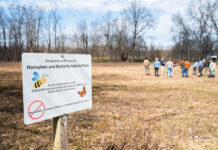
Related:
Below are some tips from Ohio State Extension and Iowa State Extension on developing a farm safety kit.
1 Know what’s in the kit
Make sure you know what is in your farm emergency kit and how to use it should an emergency arise. Get appropriate training if necessary and practice emergency situations with family members. Don’t rely on a gut instinct in a crisis situation.
2 Have multiple kits
Farmers work in several different work environments. Whether it’s in the tractor moving from field to field or tending to livestock in the barn, different environments create different emergency situations. You should also take into account the time of year, including blankets and heat sources during the colder months.
3 Individual needs
Make sure the kit includes personal medications and medical information for those who require special attention. Drugs to treat allergic reactions and any other personal medications that don’t require refrigeration should be included. The name and a phone number of the family doctor should also be included.
4 Emergency contacts
A card inside an emergency kit should include numbers for an ambulance, hospital or fire department and have written directions on how to get back to the farmstead, field or work area. Numbers for poison control and emergency road service should also be included.
5 Basic supplies
Basic supplies to include: adhesive medical tape, antibiotic ointment, antiseptic solution, gauze in assorted sizes, bandages including elastic wraps, cotton balls, instant cold packs, duct tape, plastic bags for disposal of contaminated items, sterile eye wash, thermometer, scissors (for cutting bandages or clothing), tweezers, soap or instant hand sanitizer and a first-aid manual.
6 Additional safety measures
Check your farm safety kits every three months to make sure supplies are not expired and that they fit the current season. Safety kits are important tools to have on the farm, but additional training could also be beneficial in responding to emergencies. Consider getting training in CPR, first aid or other important topics to assist when first responders can’t be on the scene immediately.
Source: Ohio State University Extension, First Aid Kits, and Iowa State University Extension, Safe Farm, Farm emergency and first aid kits.
(Farm and Dairy is featuring a series of “101” columns throughout the year to help young and beginning farmers master farm living. From finances to management to machinery repair and animal care, farmers do it all.)
More Farming 101 columns:
- 5 things young farmers should know about finances
- The farm balance sheet
- 5 items for your farm’s cash flow statement
- Personal and business records: Keep them separate
- What to include in your farm business plan
- How to approach a lender: Tips for getting a farm loan
- How to use microloans to get your farm started
- Saving for the future: 6 tips for young farmers
- 5 tips for child safety on the farm
- 6 tips for livestock safety
- 4 tips for transporting livestock
- 5 ways to better understand tractor stability
- 6 farm equipment hacks














Farm Safety is a yearlong process. Spring, summer, fall and winter farm activities have seasonal activities in fields, working livestock, repairing machinery, farm shop projects, traveling roads and highways and many more activities that should be a reminder to being safe concerns for self, family, visitors and employees.
Having safety kits, knowing where kits are, what items are used for various purposes and contact information are so important to reducing harm to an individual.
Youth living and visiting farms and ranches should be instructed and taught safety as a high priority. Visiting county and state fairs and other events pose dangers to people. Fire and rescue departments with trained volunteers as first responders need essential information to the accident scene. Time so important when an individual is injured. Hospital staff need to be contacted as to the nature of individual injuries.
All ages of individuals can be injured in a second due to hearing, visual limitations and machinery negligence.
Life is to short and all means requires to think and act safely.